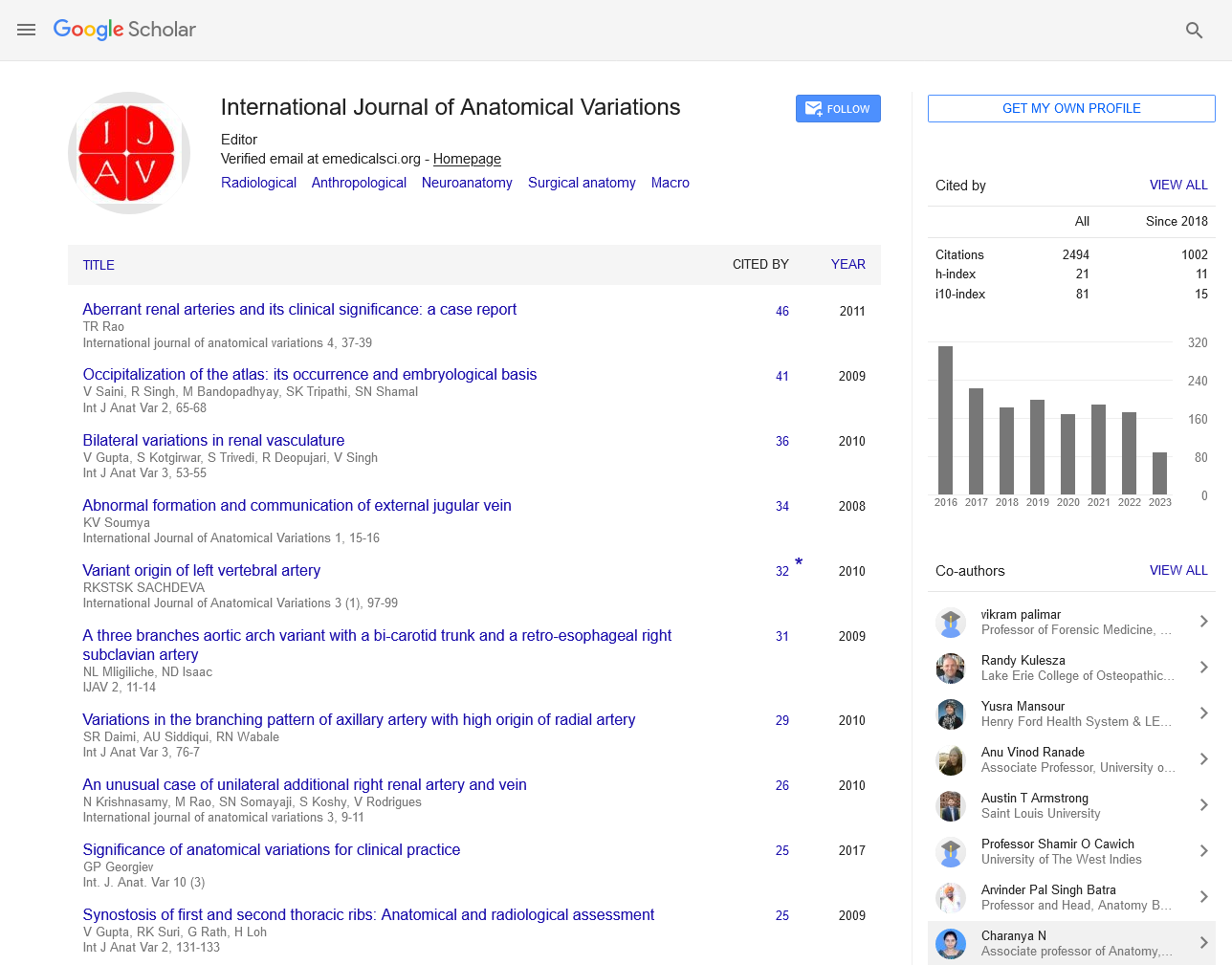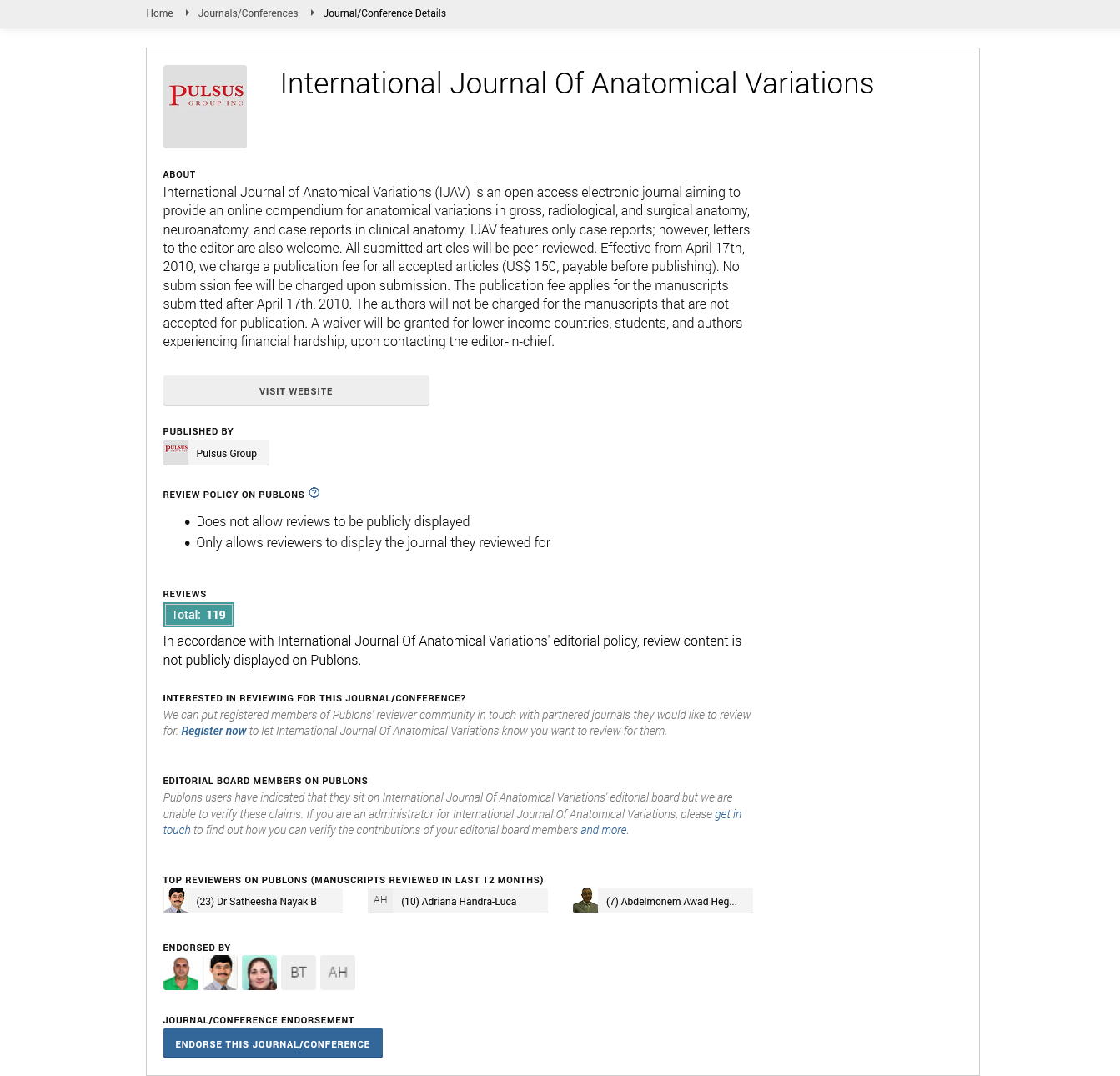Variation in the Shape of the Mandible and Its Role in Orthognathic Surgery
Received: 02-Jan-2025, Manuscript No. ijav-25-7545; Editor assigned: 04-Jan-2025, Pre QC No. ijav-25-7545 (PQ); Reviewed: 18-Jan-2025 QC No. ijav-25-7545; Revised: 24-Jan-2025, Manuscript No. ijav-25-7545 (R); Published: 31-Jan-2025, DOI: 10.37532/1308-4038.18(1).477
Citation: Diallo AY. Variation in the Shape of the Mandible and Its Role in Orthognathic Surgery. Int J Anat Var. 2025;18(1): 723-724.
This open-access article is distributed under the terms of the Creative Commons Attribution Non-Commercial License (CC BY-NC) (http://creativecommons.org/licenses/by-nc/4.0/), which permits reuse, distribution and reproduction of the article, provided that the original work is properly cited and the reuse is restricted to noncommercial purposes. For commercial reuse, contact reprints@pulsus.com
INTRODUCTION
The mandible, or lower jaw, plays a pivotal role in facial aesthetics, occlusion, and the functionality of the oral and maxillofacial regions. Its shape and size can vary significantly among individuals, and these variations can be influenced by genetics, environmental factors, and developmental conditions. In some cases, these variations lead to conditions that may require surgical intervention, particularly in the form of orthognathic surgery, a procedure aimed at correcting malocclusions and restoring facial symmetry. Variations in the shape of the mandible can present unique challenges in surgical planning and execution. Therefore, understanding these variations is crucial for maximizing the effectiveness and outcomes of orthognathic surgery. This article explores the different types of mandible shape variations, their clinical implications, and how they influence the approach and techniques used in orthognathic surgery [1].
EMBRYOLOGICAL DEVELOPMENT OF THE MANDIBLE
The mandible forms from the first pharyngeal arch during embryonic development. Initially, the mandible exists as two separate bones that fuse at the midline during fetal development. As the individual grows, the mandible undergoes significant remodeling, guided by genetic factors, functional demands, and environmental influences. The shape and structure of the mandible are influenced by the development of the surrounding facial skeleton and musculature, as well as the forces exerted by chewing and other oral activities. Variations in these processes can lead to differences in the size, shape, and alignment of the mandible. In some individuals, abnormal mandibular growth patterns may arise due to genetic disorders, craniofacial syndromes, or disturbances in the normal development of the first arch. Such variations may result in significant malocclusions, asymmetry, or functional deficits that can affect speech, chewing, and overall facial appearance. These developmental abnormalities often necessitate surgical intervention to correct the underlying issues and restore proper alignment and function [2].
TYPES OF MANDIBULAR SHAPE VARIATIONS
Several types of mandibular shape variations exist, each presenting its own set of challenges for diagnosis and treatment. One of the most common mandibular variations is the retrognathic mandible, where the mandible is positioned too far posteriorly relative to the maxilla, leading to an underbite or class II malocclusion. This condition is typically characterized by a short or retruded lower jaw, which can affect both the aesthetics of the face and the functionality of the bite. Another common variation is the prognathic mandible, where the mandible is positioned too far forward, resulting in an overbite or class III malocclusion. A prognathic mandible is often associated with a prominent chin and can cause difficulties in chewing, speaking, and maintaining a proper occlusion. This condition may arise from abnormal mandibular growth or be linked to craniofacial syndromes, such as Crouzon syndrome or mandibulofacial dysostosis. Mandibular asymmetry is another variation that can complicate facial appearance and occlusion. In this condition, one side of the mandible may be larger or positioned differently than the other, leading to facial imbalance. Asymmetry can result from a variety of factors, including congenital deformities, trauma, or conditions like hemifacial microsomia, where one side of the face does not develop normally [3].
ROLE OF ORTHOGNATHIC SURGERY IN MANAGING MANDIBULAR VARIATIONS
Orthognathic surgery is the primary treatment for addressing significant mandibular shape variations that affect facial aesthetics, occlusion, and function. The goal of the surgery is to reposition the mandible to improve alignment and achieve a more balanced facial profile while ensuring that the upper and lower jaws fit together properly for optimal bite function. This surgical intervention is commonly used to treat individuals with retrognathia, prognathia, and mandibular asymmetry. In cases of retrognathia, orthognathic surgery may involve the advancement of the lower jaw, typically through a procedure known as mandibular advancement osteotomy. This surgery repositions the mandible forward to improve facial harmony and correct the malocclusion. For individuals with a prognathic mandible, the opposite procedure, called mandibular setback osteotomy, may be performed to reposition the mandible posteriorly. In cases of mandibular asymmetry, the surgical approach will depend on the nature and extent of the asymmetry. Procedures like hemimandibulectomy or mandibular contouring may be used to correct disproportionate jaw growth, while bilateral sagittal split osteotomy (BSSO) is commonly employed for repositioning the entire mandible. These procedures aim to improve facial symmetry, functional occlusion, and enhance the overall appearance of the lower face [4].
PREOPERATIVE CONSIDERATIONS AND DIAGNOSTIC IMAGING
Before performing orthognathic surgery, accurate diagnosis and assessment of mandibular shape variations are crucial. Imaging plays a critical role in planning the surgery and understanding the specific anatomical alterations of the mandible. Techniques such as cone-beam computed tomography (CBCT) and 3D imaging are invaluable for providing detailed views of the mandible, maxilla, and surrounding structures. These imaging techniques allow surgeons to assess the degree of malocclusion, determine the best surgical approach, and create customized treatment plans that ensure optimal outcomes. Additionally, preoperative evaluations often include a thorough clinical examination, including the analysis of the patient's facial symmetry, bite relationship, and functional issues such as speech and chewing difficulties. This comprehensive evaluation ensures that the surgery addresses both aesthetic and functional concerns, improving not only the appearance of the mandible but also its ability to perform essential tasks like mastication and speaking [5].
POSTOPERATIVE CARE AND RECOVERY
Postoperative care following orthognathic surgery is critical for achieving successful outcomes. Recovery typically involves a period of swelling, bruising, and discomfort, which gradually subsides as the healing process progresses. Patients may be required to follow a soft or liquid diet for several weeks while the bone and tissues heal. Pain management, along with appropriate physical therapy to regain jaw function and mobility, is essential for a smooth recovery. In terms of long-term outcomes, patients who undergo orthognathic surgery for mandibular shape variations often experience significant improvements in both the aesthetic appearance of their face and the functionality of their bite. This leads to improved self-esteem, enhanced speech and chewing ability, and greater overall quality of life. However, as with any surgical procedure, there are potential risks, including infection, nerve damage, or relapse of the jaw position. Regular follow-up appointments are necessary to monitor healing and ensure the desired results are achieved.
CONCLUSION
Mandibular shape variations, including retrognathia, prognathia, and asymmetry, can significantly impact facial aesthetics, occlusion, and functional ability. Orthognathic surgery remains the gold standard for addressing these conditions, improving both the appearance of the jaw and its functionality. A thorough understanding of the different mandibular shape variations, along with accurate diagnostic imaging and careful preoperative planning, is essential for achieving successful outcomes in orthognathic surgery. With advancements in surgical techniques and imaging technology, patients undergoing corrective jaw surgery can expect enhanced results, improved facial harmony, and better quality of life post-surgery.
REFERENCES
- Park K-M, Yang S-S, Kim Y-W, Park KB, Park HS, et al. Clinical outcomes after internal iliac artery embolization prior to endovascular aortic aneurysm repair. Surg Today 2014; 44:472-477.
- Patel SD, Perera A, Law N, Mandumula S. A novel approach to the management of a ruptured Type II endoleak following endovascular repair of an internal iliac artery aneurysm. Br J Radiol. 2011; 84(1008):e240-2.
- Szymczak M, Krupa P, Oszkinis G, Majchrzycki M. Gait pattern in patients with peripheral artery disease. BMC Geriatrics. 2018; 18:52.
- Albulescu D, Constantin C, Constantin C. Uterine artery emerging variants - angiographic aspects. Current Health Sciences Journal 2014; 40:214-216.
- Osher M, Semaan D, Osher D. The uterine arteries, anatomic variation and the implications pertaining to uterine artery embolization. J Vasc Interv Radiol 2014; 25:S143.
Indexed at, Google Scholar, Crossref
Indexed at, Google Scholar, Crossref
Indexed at, Google Scholar, Crossref
Indexed at, Google Scholar, Crossref






